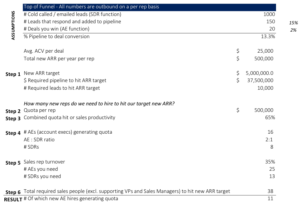From Olivier Verhage – Kennet Partners (@olivierverhage)
It’s been a while since my last blog, but now 2018 is approaching quickly and companies are prepping their budgets I thought it would be helpful to talk about forecasting or more importantly: sales hiring. When putting the budget together for next year, CEOs often underestimate sales ramp and turnover. I’ve seen a lot of situations where companies simply assume they can hire sales reps that ramp up instantly and hit 100% of their quotas. Forget it. Research by the Bridge Group points out that the average rep turnover is 35% with the average sales ramp creeping up to 5+ months, this is a big number and may the reason why hitting an overly simplistic budget seems nearly impossible. Many startup CEOs plan their budgets based on historical rep performance and set their revenue targets accordingly. For example, if a company used to generate $500k in new ARR per rep on average, adding 4 reps should get you $2M in new ARR, simple math, right? Well not exactly. Many things change once an organization scales and your sales productivity or sales efficiency may actually decline as you are now managing more sales people that need to be fed with an increasing number of leads. Assuming you are going after the low hanging fruit first, lead quality and sales conversion may decline overtime and increasing competition or price pressure can also impact your sales KPIs significantly.
The problem of the bottom up approach, which assumes a certain output per rep, is that young companies often don’t have a lot of historical sales data. Another common problem is that reps often complain they are not getting enough leads to hit their quotas. This relates to the fact that lead conversion is lower than initially anticipated and may decline overtime, so using a top down budgeting approach may work better for young companies and will tell you exactly how many leads and reps you need. A top-down budget starts by setting your ARR target for next year. For example, if you plan to grow 100% from $5M in 2017 to $10M in 2018, how many leads and reps (Account Execs; AEs or closers) do you need to get do that number? Instead of carefully assuming a certain output per rep (bottom up), we start by setting a revenue target (top down) and then work our way down as to how many account executives, SDRs and other sales support functions we need. The below overview provides a simplistic approach to determine how many new account executives you need to hire to hit your target. Here we assume an outbound sales model with average ACVs (Annual Contract Values) of $25k targeted at the mid-size enterprise.

Young companies that have gone through their first startup years often have a camp of early joiners, sales people who have been with the company since inception and have experienced the difficult early days. They are likely to stick around longer than people that joined later as they did a lot of the challenging work upfront and their jobs get increasingly rewarding as the company matures. In the example here, we assumed that the company had 3 early joiners in 2016 and hired another 2 account executives in 2017 all hitting their $500k quotas. If the company plans to grow by the same rate next year, it suddenly needs to hire twice as many people as it did the year before (assuming the same quotas and sales productivity). More people usually means more issues and a higher likelihood that some new hires may not work out as expected, we therefore assume a total sales productivity or quota hit of 65% (which is still aggressive btw) and a rep turnover of 35%. Note that rep turnover not only includes weak performers that are being let go, top reps may leave too as they are in high demand by other firms! Also note that this example does not include sales ramp. If we were to forecast productivity on a monthly basis, assume it takes 3 months to ramp to full quota for a top sales rep so if you were to hire 11 new people and half of those are hitting full quota then you would still have to adjust for ~85% since it took them 3 months to ramp up.

In this example, to hit $5M new ARR we need to hire an additional 11 AEs; this is more than twice as many as initially anticipated! Also, as sales organizations scale we need sales managers to manage individual sales teams (especially when vertically organized), SDR managers, a VP of Sales (sometimes more than one) and maybe a Chief Revenue Officer. The example here is simplistic and does not include sales management roles and senior exec hires, it should, however, give you an idea of how to build your top down sales forecast. Note that overall sales efficiency will decline overtime as more hiring means more management and so goes the saying: more people = more problems. Always hire ahead of the curve and carefully assume that you may have to hire twice as many sales guys as you might think!
